Callistemon citrinus is a beautiful flowering native tree, bringing colour as well as birds and beneficial insects to your garden. Here’s our ultimate guide to growing and caring for this Australian tree.
More...
What is a Callistemon citrinus Tree?
Genus: Callistemon
Species: C. citrinus
Family: Myrtaceae
Common Name: Crimson Bottlebrush
Flower Colour: Red
Foliage Colour: Green
Growth Habit: Small Tree to 3m
Flowering: Spring to Autumn
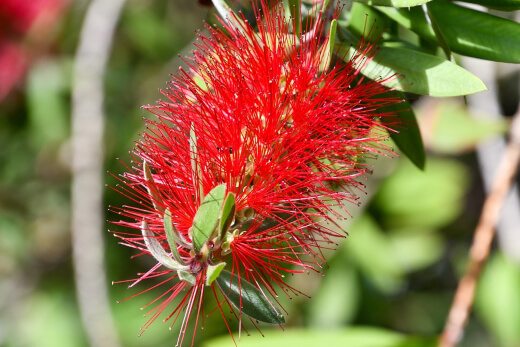
Callistemon citrinus, also called the crimson bottlebrush or lemon bottlebrush, is a native to the East Coast of Australia, although it grows well in most cooler and temperate climates as well.
Known for its fluffy bright red flowers, this small evergreen tree is a real showpiece for any garden, providing a natural food source for native nectar-feeding birds, bees and insect life.
This species of bottlebrush is known as the king of the bottlebrush family, as it is the most popular and prolific variety. With a low, willow-like canopy that is as wide as the tree is tall, it is commonly found in gardens around Australia and the world, prized for its vibrant flowers.
It is best known for its habit of often flowering twice in the same year – usually in spring and autumn. If the flowers are late for any reason, they tend to appear only once in the summer.
Check out our Bottlebrush (Callistemon) Ultimate Growing Guide.
How to Grow Callistemon citrinus
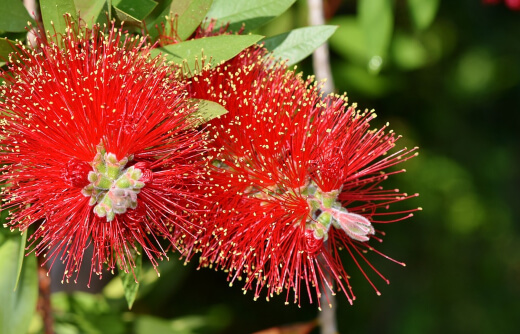
As with any tree or plant, you need the right soil, position and climate to get great results.
- Sun – The tree prefers a position with full sunlight, and will tolerate the hottest afternoon sunshine. The sunnier the position of the tree, the more flowers you are likely to get.
- Soil – This native plant is usually found in swamps, near rocky streams and along watercourses. As a result, they do tolerate poor soil conditions. Ideally, soil should be loamy, moist and well-draining.
- Water – It will need regular watering at first, but once it’s established it tolerates drought fairly well. During the first 6 months, water once a week or if you notice the soil is very dry. To ensure flowering in spring and autumn, water well in early spring if rains are minimal/late.
- Climate – This tree grows well in all Australian climates, including coastal areas, tropical areas, semi-arid environments, and both cool and warm temperate climates. It will also tolerate light frost. If heavy frost is anticipated, wrap the tree with a sheet or muslin overnight.
- Nutrients – As a native plant, it requires little or no fertiliser as it will get most of what it needs from your soil. To support strong growth, you can apply a dose of a slow release low phosphorus fertiliser like a 13-2-13, a 14-0-14 or a native blend fertiliser in the spring.
Be sure to read our garden fertiliser guide to make sure you are using the right fertiliser for your plant.
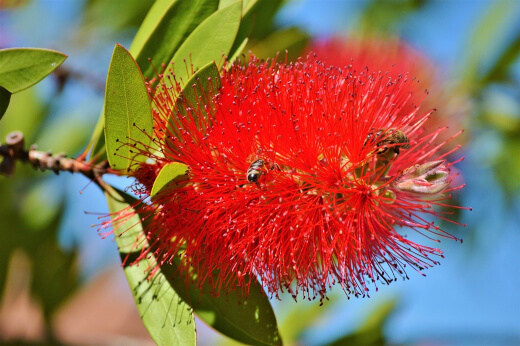
How Fast Does a Bottlebrush Tree Grow?
The bottlebrush tree grows at a fairly slow but steady pace of about 90cm per year in ideal conditions where its soil, nutrients, water and sunlight needs are met. it should grow to its full height and spread in 30 years.
Do Bottlebrush Trees Need Full Sun?
Yes – these trees need plenty of direct sunlight in order to grow well and produce their crops of flowers. They tolerate the heat of summer very well, so are the ideal tree for a hot, sunny spot in the garden.
They can tolerate a lightly shaded position, but will not produce as many flowers as a result.
Are Bottlebrush Roots Invasive?
No – bottlebrush trees are considered to have fairly non-invasive root systems. Although they will naturally try to spread towards water sources they are not known for damaging pipes, walls or foundations.
Are Bottlebrushes Toxic to Animals?
No – they are non-toxic to pets and animals.


Get Your Free Guide:
Master Growing Australian Natives eBook
A Must Have Complete Guide for Every Australian Garden
Get Your Free Guide:
Master Growing Australian Natives eBook
A Must Have Complete Guide for Every Australian Garden
Are Bottlebrush Trees Messy?
The crimson bottlebrush is an evergreen tree, so you don’t have to worry too much about the mess from the leaves themselves. The flowers, however, are well-known for shedding.
Twice a year during the warm months, you can expect to see a fine carpet of red, needle-like flower parts beneath your tree. As a result, it’s a good idea to plant your bottlebrush well away from your pool.
Callistemon citrinus Care – How to Prune a Bottlebrush
These trees don’t require pruning, but you can prune them if you want to clean them up or achieve a hedge-like screening effect. Here’s how:
- Prune after flowering – After the first set of flowers in the spring, you can lightly prune the tree back. This encourages dense growth and keeps the tree looking neat and tidy.
- Prune new growth – Don’t prune back older woody growth. Instead, prune back new growth, cutting just behind the spent flowerhead.
- Heavy pruning – These trees respond best to light pruning but can handle a heavy pruning if needed. Plan this pruning for late winter to encourage compact growth and a full crop of flowers in the spring.
Pests and Diseases
As a native plant, these trees are usually very healthy and don't generally suffer from pest or disease problems, which is one reason why Callistemon citrinus tree care is so simple.
If your bottlebrush is dying or failing to thrive, it is generally the result of poor planting conditions – the soil is too waterlogged and not draining, there is too much salt in the soil, or the tree is not getting enough sunlight.
How to Propagate a Crimson Bottlebrush
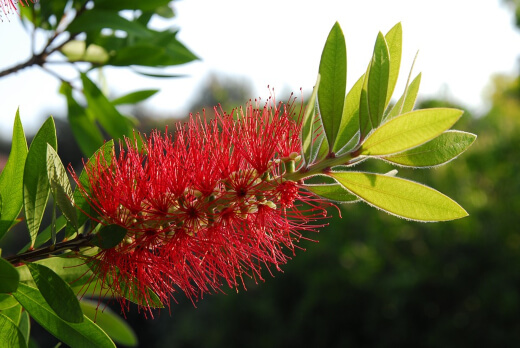
You can propagate a bottlebrush in two ways – through seeds and cuttings.
- Seeds – Collect unopened fruits from the tree. These are the hard, woody clusters left behind after the flowers are finished. Keep them in a brown paper bag in a warm cupboard until they start opening and releasing fine seeds.
Sow the seeds in a well-draining seedling mix in spring, placing the containers in a sunny spot and keeping the soil moist. Plant out in the garden when the seedlings are well-established. - Cuttings – Take a cutting about 25-20cm in size from a semi-mature branch rather than soft new growth. Use a rooting hormone mix as per the manufacturer’s instructions, and plant into a container of soil from your garden.
Keep the soil moist but make sure the container drains well. When new growth starts to appear, the tree is ready for planting.
Here is more on our Callistemon series:
How to Make Bottlebrush Tea
Did you know that you can make tea from the leaves of your Callistemon citrinus tree? Simply wash off the leaves, crush them up and pour boiling water over them to steep.
The tea can be sweetened with sugar, honey or even nectar from the tree itself. It has a lemony, refreshing flavour, which is why Callistemon citrinus is also called the lemon bottlebrush.
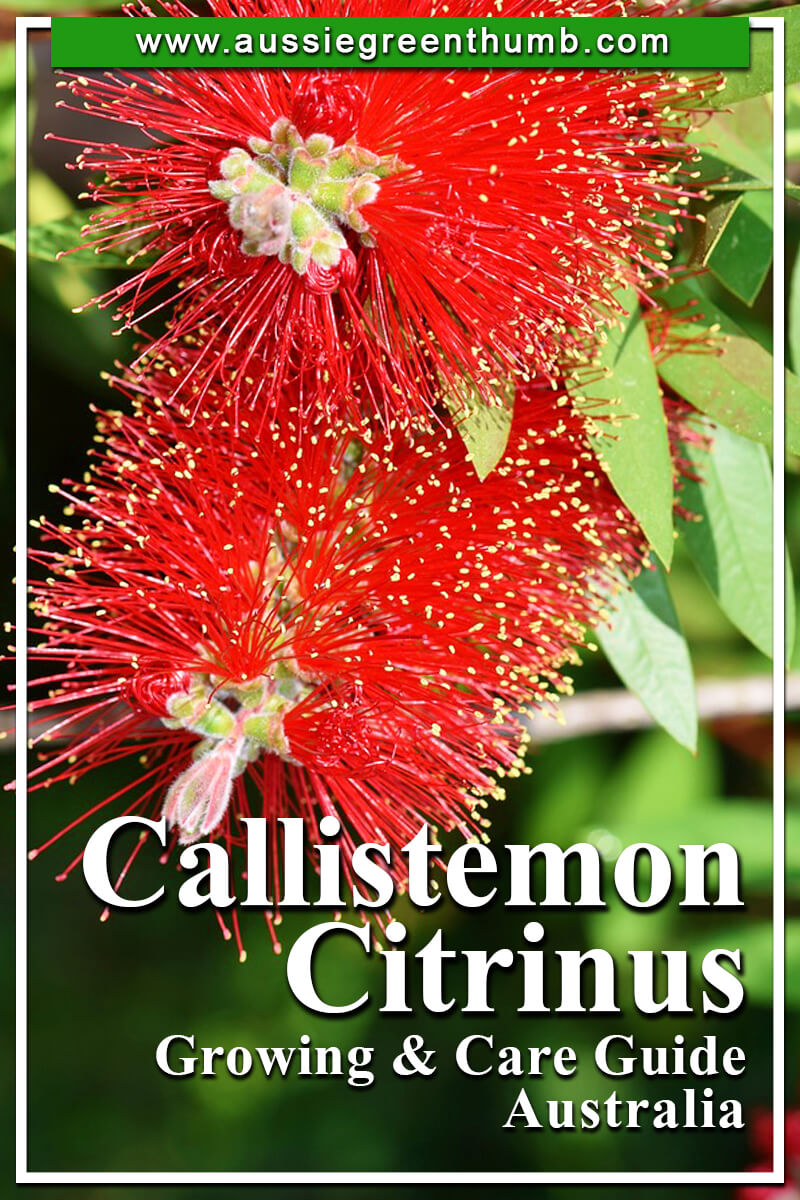
Create a Bird and Bee-Friendly Garden with the Crimson Bottlebrush
If you want to create a garden that is full of colour as well as bird and insect life, then the crimson bottlebrush is a great choice. As an Australian native, it does well in most climates around the country, including coastal regions and climates with light frost, and is fairly drought tolerant too.
It requires little to no maintenance, thriving as long as it gets the sun, space and rainfall it needs to put on its incredible show of bright red flowers twice each year.
Evergreen with a low, drooping canopy, this tree is suited to large and small gardens, and can even make a great hedge or screening tree, making it a popular choice for urban, suburban and rural settings.
Very few trees give such beautiful results with so little fuss, so no wonder the Callistemon citrinus tree is one of Australia’s most-beloved plants!
Published on September 11, 2021 by Nathan Schwartz
Last Updated on January 20, 2025




